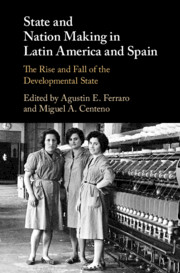Book contents
- State and Nation Making in Latin America and Spain
- State and Nation Making in Latin America and Spain
- Copyright page
- Dedication
- Contents
- Figures
- Tables
- Contributors
- Preface
- Part I Introduction
- Part II Visions and Politics of Development
- Part III Institutional Design: Infrastructural and Territorial Power
- 5 One Blueprint, Three Translations: Development Corporations in Chile, Colombia, and Peru
- 6 The Rise and Fall of the Instituto Nacional de Planificación in Peru, 1962–1992: Exploring the Limits of State Capacity Building in Weak States
- 7 A Double-Edged Sword: The Institutional Foundations of the Brazilian Developmental State, 1930–1985
- 8 Life is a Dream: Bureaucracy and Industrial Development in Spain, 1950–1990
- Part IV Industry, Trade, and Growth: Economic Power
- Part V National and Civic Identities: Symbolic Power
- Part VI Conclusion
- Index
- References
5 - One Blueprint, Three Translations: Development Corporations in Chile, Colombia, and Peru
from Part III - Institutional Design: Infrastructural and Territorial Power
Published online by Cambridge University Press: 01 December 2018
- State and Nation Making in Latin America and Spain
- State and Nation Making in Latin America and Spain
- Copyright page
- Dedication
- Contents
- Figures
- Tables
- Contributors
- Preface
- Part I Introduction
- Part II Visions and Politics of Development
- Part III Institutional Design: Infrastructural and Territorial Power
- 5 One Blueprint, Three Translations: Development Corporations in Chile, Colombia, and Peru
- 6 The Rise and Fall of the Instituto Nacional de Planificación in Peru, 1962–1992: Exploring the Limits of State Capacity Building in Weak States
- 7 A Double-Edged Sword: The Institutional Foundations of the Brazilian Developmental State, 1930–1985
- 8 Life is a Dream: Bureaucracy and Industrial Development in Spain, 1950–1990
- Part IV Industry, Trade, and Growth: Economic Power
- Part V National and Civic Identities: Symbolic Power
- Part VI Conclusion
- Index
- References
- Type
- Chapter
- Information
- State and Nation Making in Latin America and SpainThe Rise and Fall of the Developmental State, pp. 107 - 133Publisher: Cambridge University PressPrint publication year: 2018
References
- 3
- Cited by



